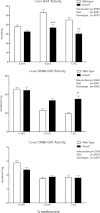Altered dietary methionine differentially impacts glutathione and methionine metabolism in long-living growth hormone-deficient Ames dwarf and wild-type mice
- PMID: 25584190
- PMCID: PMC4290132
- DOI: 10.1186/2046-2395-3-10
Altered dietary methionine differentially impacts glutathione and methionine metabolism in long-living growth hormone-deficient Ames dwarf and wild-type mice
Abstract
Background: Extending mammalian health span and life span has been achieved under a variety of dietary restriction protocols. Reducing the intake of a specific amino acid has also been shown to extend health and longevity. We recently reported that methionine (MET) restriction is not effective in life span extension in growth hormone (GH) signaling mutants. To better understand the apparent necessity of GH in the 'sensing' of altered dietary MET, the current study was designed to evaluate MET and glutathione (GSH) metabolism (as well as other pathways) in long-living GH-deficient Ames dwarf and wild-type mice following 8 weeks of restricted (0.16%), low (0.43%), or enriched (1.3%) dietary MET consumption. Metabolite expression was examined in liver tissue, while gene and protein expression were evaluated in liver, kidney, and muscle tissues.
Results: Body weight was maintained in dwarf mice on the MET diets, while wild-type mice on higher levels of MET gained weight. Liver MET levels were similar in Ames mice, while several MET pathway enzymes were elevated regardless of dietary MET intake. Transsulfuration enzymes were also elevated in Ames mice but differences in cysteine levels were not different between genotypes. Dwarf mice maintained higher levels of GSH on MET restriction compared to wild-type mice, while genotype and diet effects were also detected in thioredoxin and glutaredoxin. MET restriction increased transmethylation in both genotypes as indicated by increased S-adenosylmethionine (SAM), betaine, and dimethylglycine. Diet did not impact levels of glycolytic components, but dwarf mice exhibited higher levels of key members of this pathway. Coenzyme A and measures of fatty acid oxidation were elevated in dwarf mice and unaffected by diet.
Conclusions: This component analysis between Ames and wild-type mice suggests that the life span differences observed may result from the atypical MET metabolism and downstream effects on multiple systems. The overall lack of responsiveness to the different diets is well reflected across many metabolic pathways in dwarf mice indicating the importance of GH signaling in the ability to discriminate dietary amino acid levels.
Keywords: Aging; Ames mice; Amino acids; Longevity; Metabolomics.
Figures






References
-
- Orentreich N, Matias JR, DeFelice A, Zimmerman JA. Low methionine ingestion by rats extends lifespan. J Nutr. 1993;123:269–274. - PubMed
-
- Richie JP, Jr, Leutzinger Y, Parthasarathy S, Malloy V, Orentreich N, Zimmerman JA. Methionine restriction increases blood glutathione and longevity in F344 rats. FASEB J. 1994;8:1302–1307. - PubMed
-
- Miller RA, Buehner G, Chang Y, Harper JM, Sigler R, Smith-Wheelock M. Methionine-deficient diet extends mouse lifespan, slows immune and lens aging, alters glucose, T4, IGF-I and insulin levels, and increases hepatocyte MIF levels and stress resistance. Aging Cell. 2005;4:119–125. doi: 10.1111/j.1474-9726.2005.00152.x. - DOI - PMC - PubMed
Grants and funding
LinkOut - more resources
Full Text Sources
Other Literature Sources
Miscellaneous

